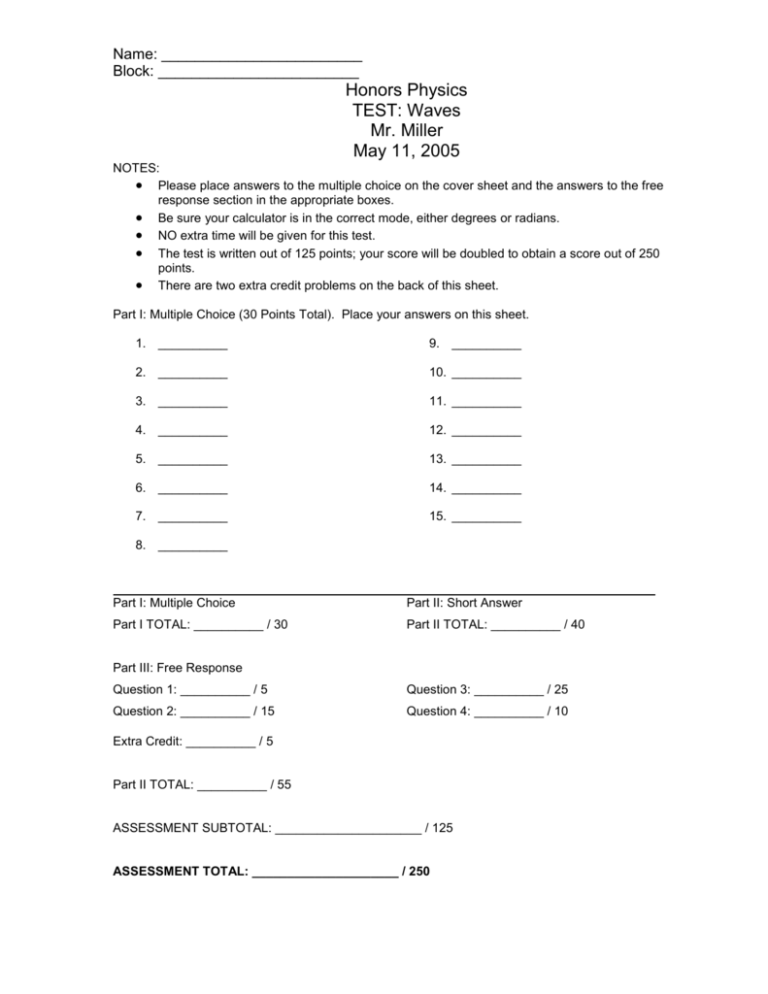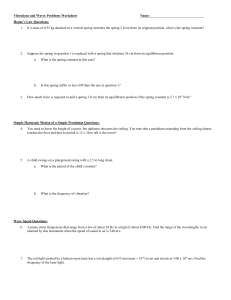test hon waves
advertisement

Name: ________________________ Block: ________________________ Honors Physics TEST: Waves Mr. Miller May 11, 2005 NOTES: Please place answers to the multiple choice on the cover sheet and the answers to the free response section in the appropriate boxes. Be sure your calculator is in the correct mode, either degrees or radians. NO extra time will be given for this test. The test is written out of 125 points; your score will be doubled to obtain a score out of 250 points. There are two extra credit problems on the back of this sheet. Part I: Multiple Choice (30 Points Total). Place your answers on this sheet. 1. __________ 9. __________ 2. __________ 10. __________ 3. __________ 11. __________ 4. __________ 12. __________ 5. __________ 13. __________ 6. __________ 14. __________ 7. __________ 15. __________ 8. __________ Part I: Multiple Choice Part II: Short Answer Part I TOTAL: __________ / 30 Part II TOTAL: __________ / 40 Part III: Free Response Question 1: __________ / 5 Question 3: __________ / 25 Question 2: __________ / 15 Question 4: __________ / 10 Extra Credit: __________ / 5 Part II TOTAL: __________ / 55 ASSESSMENT SUBTOTAL: _____________________ / 125 ASSESSMENT TOTAL: _____________________ / 250 PART I: MULTIPLE CHOICE (2 POINTS EACH) Please place answers on answer sheet. 1) As a gust of wind blows across a field of grain, a wave can be seen to move across the field as the tops of the plants sway back and forth. This wave is a a) Transverse wave b) Longitudinal wave c) Polarized wave d) Interference of waves 6) How many anti-nodes does this standing wave have? 2) The wavelength of a traveling wave is a function of: a) Frequency b) Velocity c) Amplitude d) Both choices A and B a) b) c) d) 3) The diagram illustrating two waves in phase is: One Two Three Four 7) The pictures below represent vibrating guitar strings. Which picture shows a guitar string of one and only one wavelength? a) b) c) d) 4) Destructive interference occurs because: a) Multiple waves combine to make a wave of smaller amplitude b) Waves bend around or through holes in an obstacle c) Waves are absorbed and disappear d) Two waves add up to make a wave of larger amplitude 8) Consider two identical wave pulses on a string. Suppose the first pulse reaches the fixed end of the string and is reflected back and then meets the second pulse. When the two pulses overlap exactly, the superposition principle predicts that the amplitude of the resultant pulses, at that moment, will be what factor times the amplitude of one of the original pulses? a) 0 b) 1 c) 2 d) 4 5) We often hear beats (rapid alternating between loudness and silence) when: a) Musical notes have the same frequency as the rhythm b) Two notes played at the same time have nearly the same frequency c) Sound is created as a percussionist hits a bass drum d) There is interference due to multiple echoes 9) Tripling the tension in a guitar string will result in changing the wave velocity in the string by what factor? a) 0.58 b) 1.00 c) 1.73 d) 3.00 Page 1 10) If the frequency of a traveling wave train is increased by a factor of three in a given medium, which of the following is the result? a) Amplitude is one third as big b) Amplitude is tripled c) Wavelength is one third as big d) Wavelength is tripled Questions 14-15: Two pulses are shown traveling in opposite directions on a rope. 14) After one second, the crest C and trough D are at point P. Which shape best represents the shape of the rope at this time? 11) Sound waves are always a) Transverse waves b) Longitudinal waves c) Electromagnetic waves d) Seismic waves 12) A period wave travels along a stretched string in the direction shown by the arrow. The sketch shows a “snapshot” of the pulse at a certain instant. Points A, B, and C are on the string. Which entry in the table below correctly describes how the particles of the string between A and B and B and C are moving? 15) Which best represents the shape of the rope one second later (i.e., one second after crest C and trough D were at point P)? (d) none of these between A and B a) Down b) Up c) Left d) Up e) Down between B and C down up right down up 13) By what factor does the velocity on a string chance when the frequency is doubled? (Assume the tension remains the same) a) ¼ b) ½ c) 0 d) 2 e) 4 Page 2 PART II: Short Answer (2 points each) 1. In a stretched string, what variables does wave velocity depend upon? ________________ 2. What phase is a wave that is reflected from a more rigid medium? ________________ 3. What phase is a wave that is reflected from a less rigid medium? ________________ 4. What phase is a wave that is transmitted from a more rigid to less rigid medium? ________________ 5. What phase is a wave that is transmitted from a less rigid to more rigid medium? ________________ 6. What variable(s) stays the same when a wave is transmitted across a boundary? ________________ 7. When waves enter a more rigid medium, what happens to their velocity? ________________ 8. When waves enter a more rigid medium, what happens to their wavelength? ________________ 9. When waves enter a less rigid medium, what happens to their velocity? ________________ 10. When waves enter a less rigid medium, what happens to their wavelength? ________________ 11. What type of interference occurs when two waves meet in phase? ________________ 12. What type of interference occurs when two waves meet out of phase? ________________ 13. What type of wave is shown below? ________________ On the wave above, label the: 14. compressions, 15. rarefactions, and 16. wavelength 17. What type of wave is shown below? ________________ One the wave above, label the: 18. amplitude, 19. wavelength, 20. crest and trough. Page 3 PART III: FREE RESPONSE These questions are open response questions. Please show all work, including the formulas used. Be sure to include units for all answers. Place answers in the given boxes. PROBLEM 1 (5 Points): A fisherman notices that wave crests pass the bow of his anchored boat every 3.0 s. He measures the distance between two crests to be 8.5 m. How fast are the waves traveling? v= PROBLEM 2 (15 Points): A. Discuss the similarities and differences between the two types of waves examined in the Slinky and Snaky lab. ____________________________________________________________________________________ ____________________________________________________________________________________ ____________________________________________________________________________________ ____________________________________________________________________________________ ____________________________________________________________________________________ ____________________________________________________________________________________ ____________________________________________________________________________________ ____________________________________________________________________________________ ____________________________________________________________________________________ ______________ B. Light and sound waves are extremely different. In a well-constructed response, examine these differences. In your answer, assume that the reader knows VERY little about physics; therefore, clearly explain the terminology you use. ____________________________________________________________________________________ ____________________________________________________________________________________ ____________________________________________________________________________________ ____________________________________________________________________________________ ____________________________________________________________________________________ ____________________________________________________________________________________ ____________________________________________________________________________________ ____________________________________________________________________________________ ____________________________________________________________________________________ ____________________________________________________________________________________ _______ Page 4 PROBLEM 3 (25 Points): One end of a horizontal string of linear density 4.3 x 10 -4 kg/m is attached to a small-amplitude mechanical 120-Hz vibrator. The string passes over a pulley, a distance L = 1.50 m away, and weights are hung from this end as shown in the figure. What mass m must be hung from this end of the string to produce a standing wave with A. one loop B. five loops? C. Now, the length of the string may be adjusted by moving the pulley. If the hanging mass is fixed at 0.080 kg, how many different standing wave patters may be achieved by varying L between 10 cm and 1.5 m? (be sure to show work for partial credit) D. Why can the amplitude of the standing wave be much greater than the vibrator amplitude? ____________________________________________________________________________________ ____________________________________________________________________________________ ____________________________________________________________________________________ ____________________________________________________________________________________ _________________________________________________ A. m = B. m = C. D. answer above PROBLEM 4 (10 Points): Page 5 The waves shown in the diagram below are square pulse waves. If wave I meets wave II, shown their superposition on the line below. I: 2 1.5 1 0.5 0 0 2 4 6 8 10 12 14 16 18 20 0 2 4 6 8 10 12 14 16 18 20 6 8 10 12 14 16 18 20 -0.5 -1 -1.5 -2 II: 2 1.5 1 0.5 0 -0.5 -1 -1.5 -2 Superposition: 2 1.5 1 0.5 0 0 2 4 -0.5 -1 -1.5 -2 We’re almost done with the year? I can’t believe that our ride together is coming to an end. What’s up with you? How are you doing? What’s new? ____________________________________________________________________________________ ____________________________________________________________________________________ ____________________________________________________________________________________ ____________________________________________________________________________________ ____________________________________________________________________________________ ____________________________________________________________________________________ ___________________________________ Page 6 EXTRA CREDIT 1 (2 POINTS) The ripples in a certain groove 12.8 cm from the center of a 33-rpm phonograph have a wavelength of 1.70 mm. What will be the frequency of the sound emitted? f= EXTRA CREDIT 2 (3 POINTS) Show that the frequency of standing waves on a string of length L and linear density m, which is stretched to a tension FT, is given by f n 2L where n is an integer. Page 7 FT








